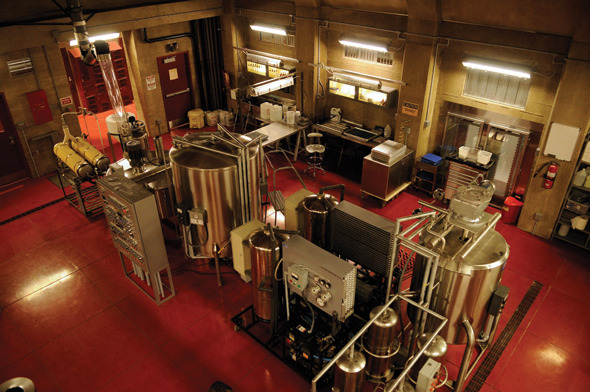Last weekend I went to a very rural place for a wedding and I had a lot of time to think on the 8 hour car ride staring at golden fields of cereal and giant concrete grain elevators. This is what I came up with.
100 acres of well irrigated flat field located somewhere in Northern Idaho, Washington or Montana which has the highest rates of ergot infection on cereal crops in North America post 2010.
 http://www.agcanada.com/wp-content/u.../GNN131112.pdf
http://www.agcanada.com/wp-content/u.../GNN131112.pdfThe field will be seeded with genetically modified ergot
Susceptible Rye. Seeds could be sourced or stolen from Switzerland (Sandoz), Germany (Boehringer Ingelheim) or China (Zhejiang Chiral Medicine Chemicals Co Ltd). I could also pay a lab to modify the seeds for me. Others producers include India, Finland and Poland.
As the Rye grows there will be an ergot spore culture being incubated in a 1000L bio reactor. The spore solution will be mixed with a surfactant to stick more easily to the rye. The solution will periodically be sprayed and injected into the rye crop. The best time for inoculation by injection is when the ears escape from the uppermost leaf sheath. This is about two weeks before the opening of the inflorescences. The first sclerotia appear about 1 month after inoculation and need a further 3-4 weeks to ripen. Harvest starts when the longitudinal growth ends and the sclerotia loosen between the glumes. The ,aom areas for field production were in Switzerland, Hungary, Czechoslovakia and Yugoslavia. The yields, averaging an estimated amount of 200kg/ha (180lb/acre) of dry ergot sclerotia, could vary on a factor of about 2.5 upwards or downwards depending on climatic or cultural conditions. Today the yields of leading producers using modified rye and enhanced ergot cultures are over 1000kg/ha.
At harvest time the grains will be harvested exactly the same as a normal rye harvest, using machinery. The grain should be of very "Low grade" with lots of black sclerotia kernals. These are normally sorted with expensive machines for infected grains which are thrown out, this cleaning process is very costly for cereal grain producers.
http://www.enormouselk.com/?q=erkkasblog/threshing-ryeErgot Sclerotia will need to be processed in a 10,000L vessel filled with low grade cheap bulk solvent. The process is described in detail in US Patent 2255124 and another patent that I thought I had but lost, I will find it again one day but I remember the basic outline of it. Instead of using water to seperate the infected rye from the non infected grains, non polar solvent is used instead of water which eliminates any possibility of alkaloid degradation and allows defatting and extraction to be done in one vessel. The ergot grain will sink to the bottom and the floating grains discarded. Petroleum Ether will be used to defat. The entire biomass can then be macerated and extracted. Ph is adjusted in the alcohol/ergot solution and alkaloids extracted. The entire biomass cis washed, enhancemented, extracted and recrystallized. The yield should be somewhere around 100kg or Ergot Salt (ET) per x acres of rye.
To convert ET to LSA the best way would be to react everything at once in one go instead of small batches to avoid allowing the salts degrading. 100kg can be reacted in 4-5 100L stain steel pharma grade industrial reactors. First the ET is hydrolysed into LSA. After that the LSA is to be reacted in a battery of 50L flasks in a room with special dark lighting. The classic peptide coupling method will be used (LSA dissolved in HATU/HOBT) which runs cold and minimizes hazardous precursors like hydrazine and diethylamine. The only drawback being high cost and difficulty sourcing reagents. The room where the LSD is being manufactured will have an industrial air purification system with a HEPA enhancement to minimize infamous "LSD dust" from tainting the work environment. The workers will wear full body protection suits with oxygen breathers and Thorazine in the bloodstream to minimize LSD poisoning. LSD is non toxic but is well known for its psychoactive properties in small amounts. No laboratory in human history has ever made this much LSD before but clandestine accounts of labs operating in the 1kg+ range report workers in a constant state of intoxication even from handling or being near equipment used in manufacture.
https://erowid.org/archive/rhodium/c...ng.agents.html-LIQUID ERGOT CULTURE-

liquid ergot culture will be produced along with wild ergot and they will be acting symbiotically towards each other. The wild ergot can be used for the liquid ergot culture and liquid ergot culture used to infect more rye.
After final crystallization there will be two products. Needlepoint pure LSD crystal which will be stored in opaque glass/plastic in an oxygenless deep freezer away from any source of light. The second product is Iso-LSD, removed during purification and dissolved in solvent (byproduct of LSD synthesis from LSA). This inactive compound can be sold or converted to LSD. The LSD would best be transported by refrigerated trucks. The bottles of LSD crystal will be in styrofoam boxes surrounded by dry ice and should be kept cold at all times. The crystal can be dissolved in alcohol and laid onto blotter by anyone who knows the process. It might be possible to rig a machine that can lay all the LSD solution onto 100 feet of blotters like a conveyer belt and the sheets vacuum sealed and kept in cold storage.

The entire process should take a few years per batch. 1 year to culture ergot, 1 year to grow, infect and harvest sclerotia And 1 month of working around the clock, night and day with little sleep to convert all the ergot into LSD.








